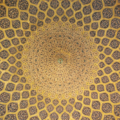 Most people know that Rumi was a Sufi and that the whirling dervishes are Sufis, but that about sums up their Sufi expertise. So, I’m going to provide you with a few other fundamentals, as I understand them.
Most people know that Rumi was a Sufi and that the whirling dervishes are Sufis, but that about sums up their Sufi expertise. So, I’m going to provide you with a few other fundamentals, as I understand them.
It is mystical: Sufism is not a separate sect of Islam, but an ascetic and love-oriented mystical order within it. “My lips got lost on the way to the kiss—that’s how drunk I was,” begins Rumi in one of his love poems to God, and this sums up the intensity of Sufi devotion. They work at purifying themselves of even the smallest iota of selfishness so that nothing they do, say, or think will defy God–but rather, will serve as a form of prayer that draws them closer into God’s divine embrace.
It is Muhammad-oriented: Sufis revere Muhammad as the exemplar of spiritual greatness. According to Fariduddin Attar, “Muhammad is … the sun of creation, the moon of the celestial spheres, the all-seeing eye…The seven heavens and the eight gardens of paradise were created for him; he is both the eye and the light in the light of our eyes.” Accordingly, another Sufi, Bayazid Bastami, reportedly refused to eat a watermelon because he couldn’t be certain whether Muhammad had ever eaten one.
Sufis also believe in Muhammad’s ability to intercede. In fact, Rumi attributes his abstinence from worldly desires as a quality attained through the guidance of Muhammad. He states, “I sewed my two eyes shut from [desires for] this world and the next – this I learned from Muhammad.”
It is Order-oriented: In the eleventh-century, Sufism, which had previously been a less codified trend in Islamic piety, began organizing into orders, each of which was founded by a major Islamic saint. Sufis believe that by pledging allegiance to an order, and thereby, to its saint, one is pledging allegiance to the Prophet Muhammad, and through this establishing a spiritual link with him.
Devotional Practices: These vary widely, according to author Hakim Moinuddin Christi, because “an acknowledged and authorized master of the Sufi path is in effect a physician of the heart, able to diagnose the seeker’s impediments to knowledge and pure intention in serving God, and to prescribe to the seeker a course of treatment appropriate to his or her maladies.” Nonetheless, the following practices are common.
- A lifestyle that eschews worldliness and that strictly adheres to Islamic strictures.
- Muraqaba, similar to meditation. Here’s a description of it within the Naqshbandi lineage:
“He is to turn his full consciousness towards God Most High while saying three times (in Arabic) “My God, you are my Goal and Your good pleasure is what I seek”. Then he brings to his heart the Name of the Essence— Allâh —and as it courses through his heart he remains attentive to its meaning, which is “Essence without likeness”. The seeker remains aware that He is Present, Watchful, Encompassing of all.”
- Dhikr, in which dervishes (and all devout Muslims) become absorbed in the rhythmic repetition of the name of God or of God’s attributes. In the case of dervishes, this is coupled with physical movement, specifically dancing, which helps induce an ecstatic, trance-like state.
As mentioned, whirling dervishes are an example of this, in which they perform a stylized dance called the Sema, said by some to imitate the movement of planets orbiting the sun. Additional symbolism within it includes the following:
The hat the dervish wears “represents the tombstone of the ego; the wide, white skirt the ego’s shroud. By removing his black cloak, he is spiritually reborn to the truth.
At the beginning of the spinning, by holding his arms crosswise, (he) appears to represent the number one, testifying to God’s unity. While whirling…his right arm is directed to the sky, ready to receive God’s beneficence; his left hand…toward the earth…conveys God’s spiritual gift to all those who witness the Sema. Revolving from right to left around the heart, (he) embraces all humanity with love.” whirlingdervishes.org
